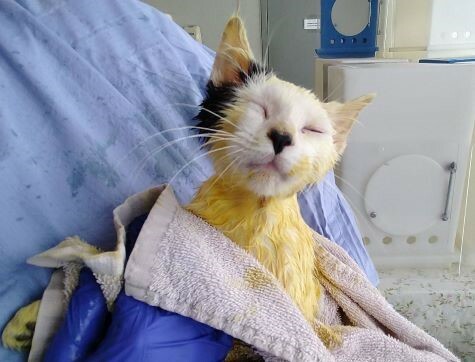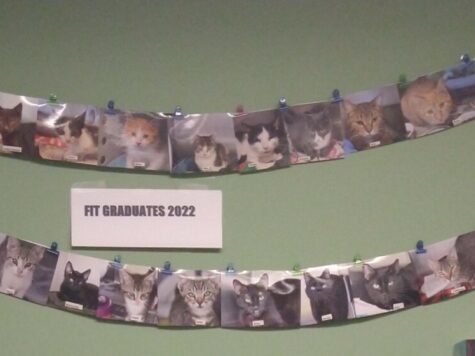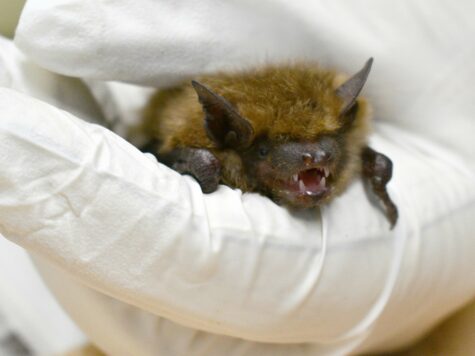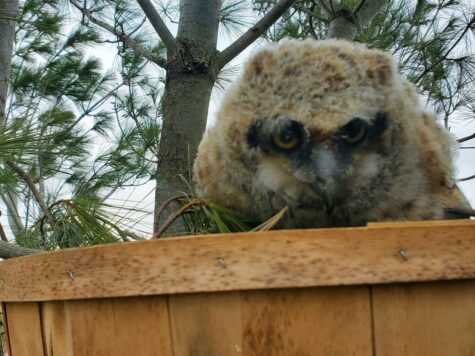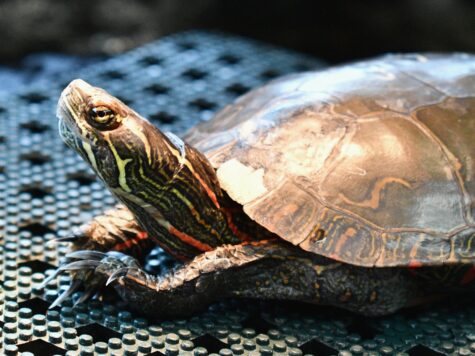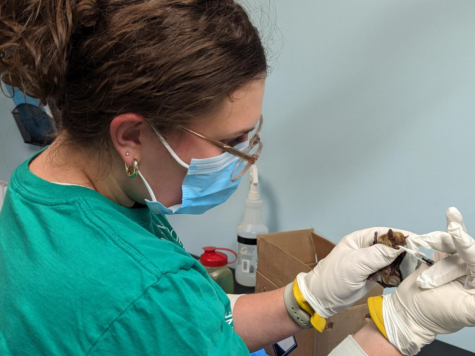“I knew Gimlet was special from the first time I met him.”
Andrea Burton volunteers in Dane County Humane Society’s (DCHS’s) Maddie’s Felines in Treatment Center. She recently met kitten Gimlet during his stay, and he quickly captured her heart.
Gimlet arrived at the shelter on a cold winter day in January 2023 after he was found wandering all alone on a rural property. The twelve-week-old kitten came right up to a young girl, and her mother called DCHS to see if we could help this little kitty in need. He was very friendly, but his eyes and some hair loss posed immediate concerns. His finder didn’t think he could see well, and he had a small, hairless patch on one of his legs and hair loss on his ears.
As part of every initial exam for cats, admitting technicians pay close attention to fur and skin, and shine a special ultraviolet light called a Wood’s lamp over the cats’ bodies to check for the strain of ringworm that is most likely to cause outbreaks in shelters. The fungus is highly contagious and can quickly spread throughout the entire animal population, including to dogs and humans. This high transmissibility makes ringworm difficult to manage in a shelter setting, so it is important to diagnose the fungus early.
In fact, ringworm was once a feline death sentence. It causes hair loss and itchy or scaly skin, increasing the risk of skin wounds and other infections. But more concerning is how rapidly and broadly it can spread. Ringworm was considered untreatable in a shelter setting. To prevent the spread of the fungus to healthy animals, ringworm-positive cats were often euthanized.
In 2003, DCHS launched a program that would change everything.
The Felines in Treatment (F.I.T.) program started in a pink, 1960s-era trailer and has since moved to a permanent building next to the shelter. The Maddie’s F.I.T. Center is completely separate from the main shelter, providing isolation from the rest of the shelter’s animal population, a low-stress environment to treat sick kitties, room to store supplies and equipment, and facility-specific HVAC, electrical, and hot water systems. The Maddie’s F.I.T. Center even has an entirely separate team of volunteers. All of this helps ensure ringworm does not spread to the rest of the shelter population.
DCHS’s innovative F.I.T. program literally saves cats’ lives.
The Wood’s lamp test can be very effective in detecting the most common and contagious strain of ringworm, making it a good, initial assessment. Gimlet’s test came back negative, but DCHS veterinarians suspected his hair loss could be due to a less common strain of the fungus. They should know; they have diagnosed their fair share of it. They took samples for fungal culture.
During his exam, they also took a close look at Gimlet’s eyes, which were nearly opaque with limited vision. Veterinary staff diagnosed him with severe conjunctivitis, significant corneal disease, an ear infection, and an upper respiratory infection. Fortunately, his eyes didn’t seem to cause him pain, so our veterinarians decided they didn’t need to surgically remove them. Instead, they started him on antibiotics for the infection and ointments for his eyes.
Unfortunately, the damage wasn’t reversible, and he’ll likely always have limited vision.
Gimlet loved the attention during his exam and purred loudly. If staff stopped touching him, he’d cry for more.
The fungal culture indicated Gimlet did indeed have ringworm. He was otherwise comfortable and healing well from his other health concerns, so he was admitted to a spacious kitty condo in the Maddie’s F.I.T. Center for ringworm treatment.
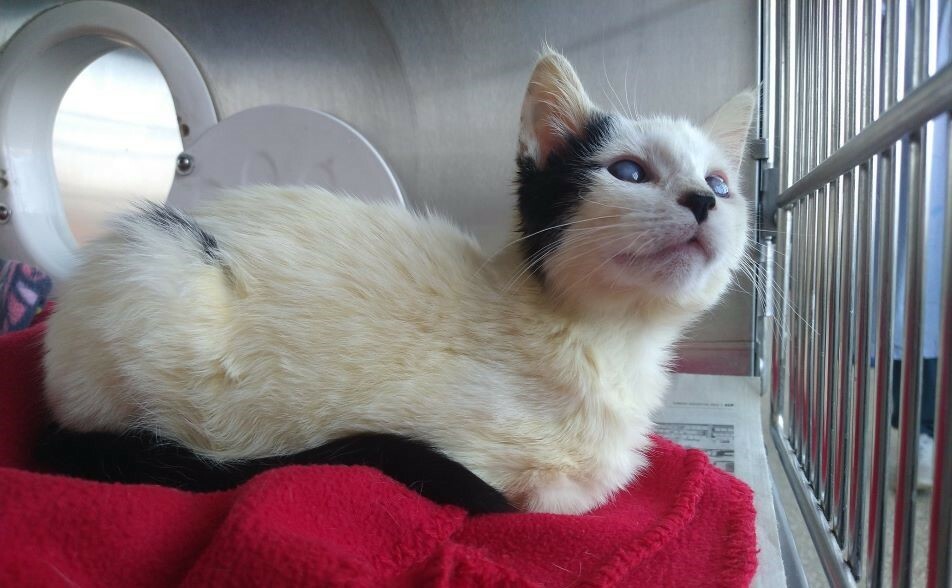
He was one step closer to healing from the fungal infection – and little did anyone know, he was one step closer to finding his new family.
The Maddie’s F.I.T. Center is almost entirely run by dedicated volunteers – about 30 of them, including Andrea. As part of the treatment, volunteers administer oral anti-fungal medications to the cats, and they spray the cats’ bodies with a lime-sulfur solution twice-weekly. The F.I.T. team calls the spray treatment a dyp, which came from the brand of product they used on the cats, and the volunteers who treat the cats are often called dyppers. Dyppers also drench washcloths with the lime-sulfur solution to gently coat the fur around kitties’ faces and ears, making sure to avoid their eyes.
“After applying the topical treatment to the cats, I always sit with them and towel them off,” says Andrea. “I found myself spending a little more time with and attention to Gimlet. Despite his health issues, he was vocal, confident, and friendly, coming right up to the cage door to greet anyone who passed by, and would purr immediately when being petted or held.”
But there’s more to the program than physical healing. Dyppers speak in soothing tones to try to comfort the cats as they’re being sprayed with the solution or to encourage them to swallow their medicine. These F.I.T. volunteers also provide cats with much-needed cuddles, pets, and attention. When F.I.T. program graduates are ready for adoption, they’re often the most snuggly cats available!
“Gimlet was incredibly easygoing as well,” Andrea continues. “Most cats and kittens that I’ve treated for ringworm are pretty resistant when getting the topical treatment, but Gimlet never really put up much of a fuss.”
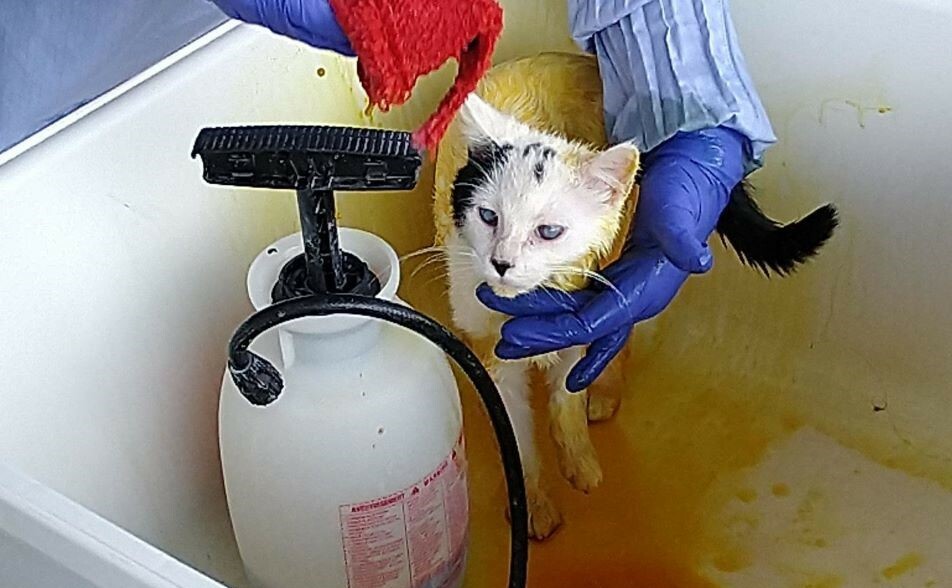
Cats undergo this ringworm treatment until fungal culture shows that the infection is resolved.
When the F.I.T. program first began, the average length of stay was about 50 days. In the early years of the program, DCHS sent cultures to the University of Wisconsin School of Veterinary Medicine for analysis. Now that DCHS’s veterinary team is trained on analyzing the cultures, they can perform these tasks onsite, which helps reduce how long cats in treatment need to stay in the Maddie’s F.I.T. Center. The average length of stay is now down to 28 days!
Each cat’s stay is different, and it’s also affected by whether the cat needs to be treated for additional medical issues. Despite his many medical needs, Gimlet’s length of stay was just 25 days!
During his stay, he was monitored by DCHS veterinarians, who checked on his eyes and upper respiratory infection. The infection had cleared up thanks to treatment, and his eyes were much better – in fact, even his limited vision had improved some!
By early February, Gimlet’s cultures indicated his ringworm infection was resolved, and with the recovery of his eyes, he was ready for adoption.
Gimlet didn’t have to look very far to find his new home.
“I knew that I wanted him to be part of our family,” says Andrea. “It took a little convincing to get my partner, Becky, on board.” Quite reasonably, Becky had some concerns. The family already had two cats, and a new kitten could upset their dynamic. And they wondered how Gimlet, with his impaired vision, would manage their two-story home.
“As soon as Becky met Gimlet, though,” Andrea says, “she fell in love like I did and knew that we just had to make this work. The rest is history.”
They brought Gimlet home on February 16th, and the family has thrived since.
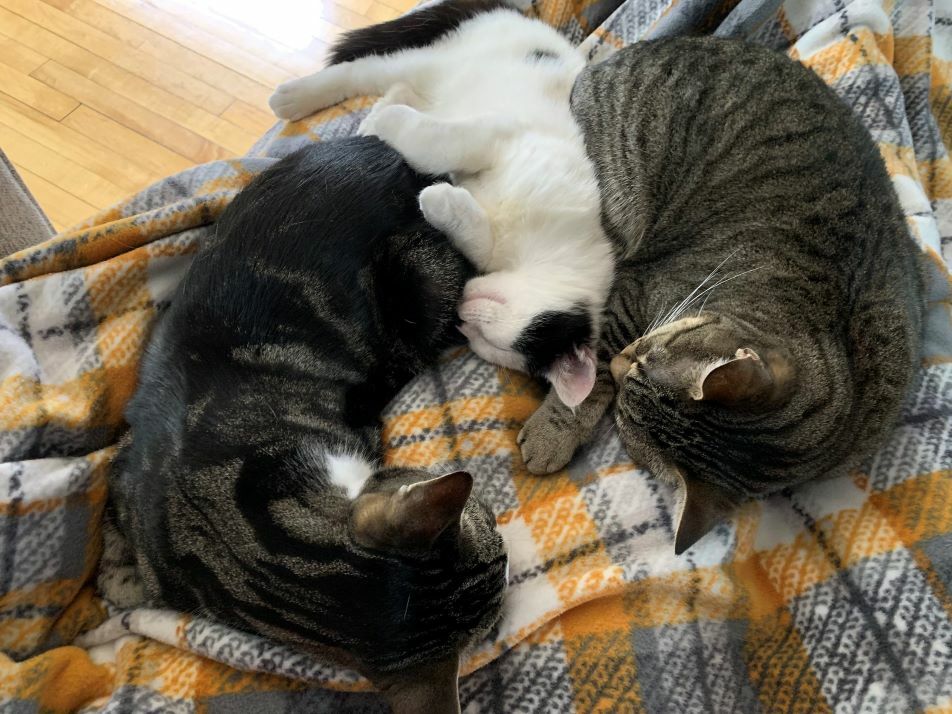
“Gimlet has been a perfect addition,” says Andrea. “He enjoys chasing around and wrestling with his big brother, Cosmo, and big sister, Martini.” Although originally named “Killian” when he arrived at the shelter, Andrea and Becky decided to change his name to fit with the theme of cat names in their household: Cosmo, Martini, and Gimlet!
“He is a total lap cat,” Andrea continues. “He’ll take naps on me or Becky whenever he gets a chance and prefers to sleep as close to our faces as possible, often with his cheek pressed up against ours. He continues to be super confident and smart; his impaired vision doesn’t slow him down one bit.
“Becky and I couldn’t be happier,” says Andrea. “We are committed to making sure Gimlet can live his very best life!”
Lisa Bernard is the Public Relations Coordinator, and Natasha Saidikowski is the Donor Engagement Coordinator
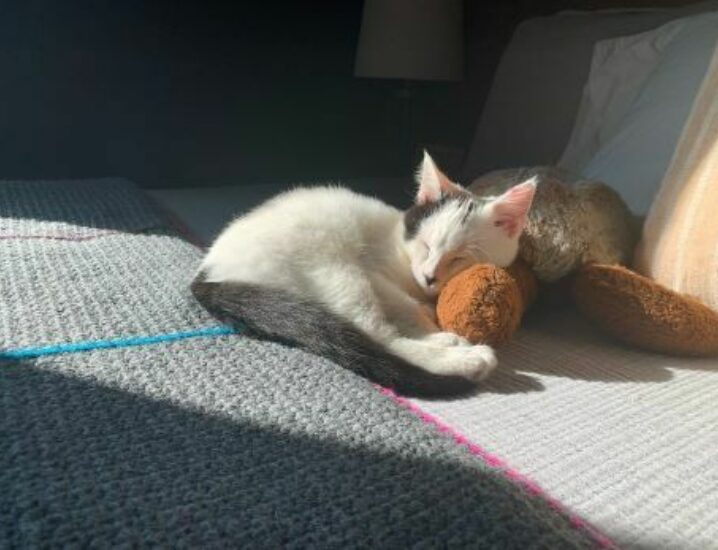
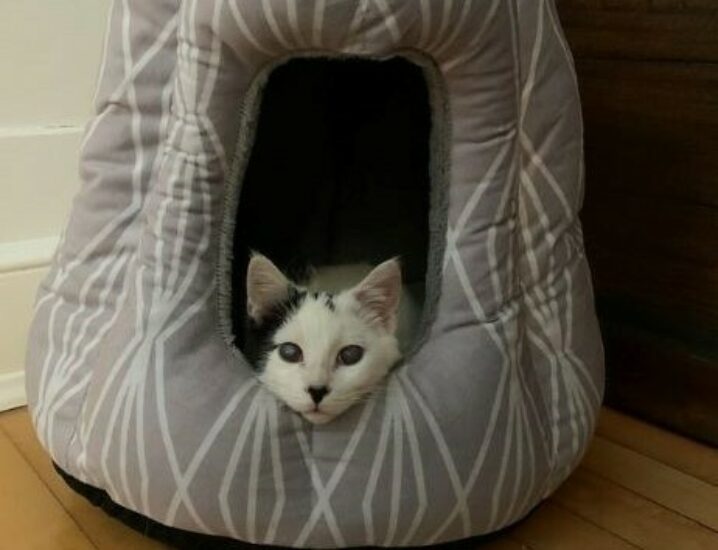
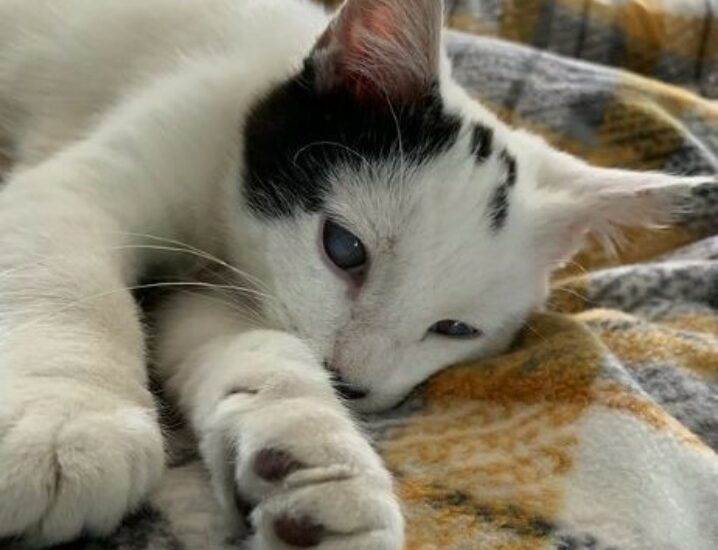
2022 Annual Report
F.I.T. Center
Animal Medical Services
